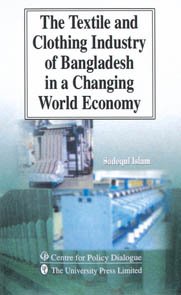 Liberalisation of trade and investment in the post-Uruguay Round period presented opportunities as well as challenges for the textiles and clothing industry of Bangladesh. This study covers several aspects of the textiles and clothing industry of Bangladesh in the context of a changing world economy. The book discusses the implications of the international trade policy regimes governed by the Agreement on Textiles and Clothing (ATC) and trade policy instruments of the major trade blocs such as the European Union (EU) and the North American Free Trade Agreement (NAFTA) for international trade in textiles and clothing. It explores the impact of tariff reductions and elimination of quotas concerning textiles and clothing on different regions of the world through a general equilibrium analysis, based on Version 4 of the Global Trade Analysis Project (GTAP) model. The work analyses the trade performances of Bangladesh and selected countries in clothing in terms of several criteria such as market shares of product and regional concentrations of trade, the Export Similarity Index and the revealed comparative advantage (RCA). The study focuses on a number of issues concerning trade and industrial policy instruments for textiles and clothing in Bangladesh and several comparator countries including India and China.
Liberalisation of trade and investment in the post-Uruguay Round period presented opportunities as well as challenges for the textiles and clothing industry of Bangladesh. This study covers several aspects of the textiles and clothing industry of Bangladesh in the context of a changing world economy. The book discusses the implications of the international trade policy regimes governed by the Agreement on Textiles and Clothing (ATC) and trade policy instruments of the major trade blocs such as the European Union (EU) and the North American Free Trade Agreement (NAFTA) for international trade in textiles and clothing. It explores the impact of tariff reductions and elimination of quotas concerning textiles and clothing on different regions of the world through a general equilibrium analysis, based on Version 4 of the Global Trade Analysis Project (GTAP) model. The work analyses the trade performances of Bangladesh and selected countries in clothing in terms of several criteria such as market shares of product and regional concentrations of trade, the Export Similarity Index and the revealed comparative advantage (RCA). The study focuses on a number of issues concerning trade and industrial policy instruments for textiles and clothing in Bangladesh and several comparator countries including India and China.
The study calls for a dynamic perspective in promoting different components of the “textiles cluster” including yarn and fabrics. The study refers to the available literature on industrial districts, and emphasises the need for continuous improvements of productivity in the textiles and clothing industry.
Contributor: Sadequl Islam
Co-published with The University Press Limited (UPL)
Publication Period: July 2001
ISBN 984-05-1567-5
Price: Tk. 250 USD 20
Hard copy of the book is available at CPD Office

